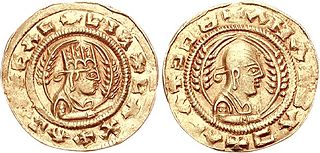Related Research Articles

Axum, also spelled Aksum, is a town in the Tigray Region of Ethiopia with a population of 66,900 residents. It is the site of the historic capital of the Aksumite Empire.
Yeha is a town in the northern Central Zone, Tigray in Ethiopia. It likely served as the capital of the pre-Aksumite kingdom of Dʿmt.

Lalibela is a town in the Amhara Region of Ethiopia. Located in the Lasta district and North Wollo Zone, it is a tourist site for its famous rock-cut monolithic churches designed in contrast to the earlier monolithic churches in Ethiopia. The whole of Lalibela is a large and important site for the antiquity, medieval, and post-medieval civilization of Ethiopia. To Christians, Lalibela is one of Ethiopia's holiest cities, and a center of pilgrimage.
The Sangoan is the name given by archaeologists to a Palaeolithic tool manufacturing style which may have developed from the earlier Acheulian types. In addition to the Acheulian stone tools, bone and antler picks were also used. Sangoan toolkits were used especially for grubbing.

The Zagwe dynasty was a medieval Agaw monarchy that ruled the northern parts of Ethiopia and Eritrea. The Agaw are a Cushitic ethnic group native to the northern highlands of Ethiopia and neighboring Eritrea. It ruled large parts of the territory from approximately 1137 to 1270 AD, when the last Zagwe King Za-Ilmaknun was killed in battle by the forces of the Amhara King Yekuno Amlak. The Zagwe are most famous for their king Gebre Meskel Lalibela, who is credited with having ordered the construction of the rock-hewn monolithic churches of Lalibela.
Yemrehana Krestos was the third king of the Zagwe dynasty, ruling during the second half of the twelfth century. His biography is recorded in the Gädlä Yəmrəḥannä Krəstos.

The Museum of Archaeology and Anthropology, also known as MAA, at the University of Cambridge houses the university's collections of local antiquities, together with archaeological and ethnographic artefacts from around the world. The museum is located on the university's Downing Site, on the corner of Downing Street and Tennis Court Road. In 2013 it reopened following a major refurbishment of the exhibition galleries, with a new public entrance directly on to Downing Street.
Stubbington House School was founded in 1841 as a boys' preparatory school, originally located in the Hampshire village of Stubbington, around 1 mile (1.6 km) from the Solent. Stubbington House School was known by the sobriquet "the cradle of the Navy". The school was relocated to Ascot in 1962, merging with Earleywood School, and it closed in 1997.

The Kingdom of Aksum also known as the Kingdom of Axum, or the Aksumite Empire, was a kingdom in East Africa and South Arabia from classical antiquity to the Middle Ages, based in what is now northern Ethiopia and Eritrea, and spanning present-day Djibouti and Sudan. Emerging from the earlier Dʿmt civilization, the kingdom was founded in 1st century. The city of Axum served as the kingdom's capital for many centuries until it relocated to Kubar in the 9th century due to declining trade connections and recurring external invasions.

Agula is a town located in northern Ethiopia. Located in the Debubawi (Southern) Zone of the Tigray Region, it lies about 32 km northeast of Mekelle, just east of the Mekelle to Addis Ababa highway, and 25 km north of Qwiha. It has a latitude and longitude of 13°41′30″N39°35′30″E with an elevation of 1,930 metres above sea level. It is one of three towns in Kilte Awulaelo woreda. Nearby is a stream and a pass which share the same name. Agula was an important station on the salt caravan route from Dallol west to Atsbi.
David William ParkFSA is a professor at the Courtauld Institute of Art, University of London, where he is Director of the Conservation of Wall Painting Department. Park is a graduate of Manchester University and Corpus Christi College, Cambridge University and has been a Fellow of the Society of Antiquaries of London since 1986.
Cyprian Broodbank, is a British archaeologist and academic. Since October 2014, he has been Disney Professor of Archaeology at the University of Cambridge and director of the McDonald Institute for Archaeological Research. From 2010 to 2014, he was Professor of Mediterranean Archaeology at University College London.

Biete Maryam is one of the monolithic rock-cut Rock-Hewn Churches, Lalibela of the Ethiopian Orthodox Tewahedo Church. It is part of the UNESCO World Heritage Site at Lalibela.
Stuart Christopher Munro-Hay was a British archaeologist, numismatist and Ethiopianist. He studied the culture and history of ancient Ethiopia, the Horn of Africa region and South Arabia, particularly their history of coins.
References
- 'PHILLIPSON, Prof. David Walter', Who's Who 2013, A & C Black, an imprint of Bloomsbury Publishing plc, 2013; online edn, Oxford University Press, Dec 2012; online edn, Nov 2012 accessed 5 March 2013